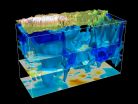New in the Hastings Center Report
Patient-satisfaction surveys: improving health care, or leading it astray? The downside of courage, right-to-try laws, and more in the May-June 2015 issue
2015-05-14
(Press-News.org) New in the Hastings Center Report
Patient-satisfaction surveys: improving health care, or leading it astray? The downside of courage, right-to-try laws, and more in the May-June 2015 issue.
Patient-Satisfaction Surveys on a Scale of 0 to 10: Improving Health Care, or Leading It Astray?
Alexandra Junewicz and Stuart J. Youngner
It is increasingly common for patient-satisfaction surveys to be used as indicators of health care quality, as well as to influence the reimbursement paid to providers. But the authors argue that the surveys could eventually compromise the quality of care and raise health care costs. "The pursuit of high patient-satisfaction scores may actually lead health professionals and institutions to practice bad medicine by honoring patient requests for unnecessary and even harmful treatments," they write. "Patient satisfaction is important, especially when it is a response to being treated with dignity and respect, and patient-satisfaction surveys have a valuable place in evaluating health care. Nonetheless, some uses and consequences of these surveys may actively mislead health care." Junewicz is a resident physician in the Department of Psychiatry at the New York University School of Medicine. Youngner is a professor of bioethics and psychiatry in the Department of Bioethics at Case Western Reserve University School of Medicine.
Must We Be Courageous?
Ann B. Hamric, John D. Arras, and Margaret E. Mohrmann
Nurses, physicians, and other health care professionals confront many moral challenges in which they feel they must act courageously to "do the right thing," stand up for patients' rights, and uphold the ethical standards of their professions. In particular, the authors write, health care providers are increasingly reminded of their moral duty to exhibit courage in the face of institutional obstacles to the proper care of their patients. If, for example, a nurse feels that an agitated patient would benefit from increased sedation, should she ask for it from a doctor, even if she knows that the doctor will hold that request against her? Failure to do so would indicate a lack of courage, according to an article cited by the authors, who offer a critical assessment of such appeals to courage. "While we find courage to be an indispensable virtue in some challenging contexts, in other settings we find invocations of courage to be both an unfortunate endorsement of an oppressive status quo that can divert attention from the real problems and an undesirable and potentially destructive strategy within health care institutions whose goal is medically excellent and morally good clinical practice," they write. "As we shall argue, a call to virtuousness is not always virtuous." Hamric is associate dean for academic affairs and a professor at the Virginia Commonwealth University School of Nursing. Arras, who died in March, was the Porterfield Professor of Biomedical Ethics and a professor of philosophy and public health sciences at the University of Virginia. Mohrmann is a professor of pediatrics, medical education, and religious studies at the University of Virginia.
Graphic Medicine: Comics Turn a Critical Eye on Health Care
Sarah Glazer
"A patient arrives in the emergency room apparently in a comatose state. But is he really unconscious or just faking? The young doctors on duty are skeptical. Failing to get a reaction with a chest rub, they try a variety of methods that become increasingly sadistic--pressing on the patient's fingernail with a ballpoint pen, spraying his testicles with a skin-freezing compound, announcing an imminent eye injection to scare the patient awake." The story was told in a 2012 graphic novel called Disrepute, part of a growing genre called "graphic medicine." Doctors, nurses, and patients are using the graphic novel form to reveal the dark underbelly of medicine, writes Glazer, a contributing writer for CQ Researcher. In a related article, Graphic Medicne in the University, Susan M. Squier, discusses her experience offering a graduate seminar on graphic medicine. "What happened surprised me," writes Squier, the Brill Professor of Women's Studies and English at Pennsylvania State University. "Not only did the students, none of whom were medical students, explore illness, disability, and medical treatment in their comics, but they often articulated bioethics issues as well."
Also in this issue:
At Law: "Right to Try" Laws: The Gap between Experts and Advocates
Rebecca Dresser
Five states have adopted "right to try" laws intended to promote terminally ill patients' access to investigational drugs. Many more state legislatures are now considering such laws. The campaign for right to try laws is the latest move in an ongoing effort to give seriously ill patients access to drugs whose safety and effectiveness remain largely unknown. Although scientists and policy-makers oppose the right to try approach, it has proven quite popular among state legislators and the public.
INFORMATION:
ELSE PRESS RELEASES FROM THIS DATE:
2015-05-14
Many television advertisers voice fears that distracted viewers -- those increasingly frenetic multitaskers using smartphones, laptops and tablets while viewing TV - are becoming less receptive to advertisers' messages. A new study published in the online Articles in Advance section of Marketing Science, a journal of the Institute for Operations Research and the Management Sciences (INFORMS), refutes this conventional wisdom and concludes that the "second screen" puts a virtual store in every consumer's pocket. Multitasking viewers now visit, browse, and even buy advertised ...
2015-05-14
An anti-poverty program tested extensively on three continents has produced sustained gains in individuals' income, wealth, and well-being, according to a study published today in the journal Science.
The program provides very poor people with productive assets, such as livestock, as well as job training, life-skills coaching, and health information. Known as the "Graduation" program, its intention was to examine whether helping the poor in multiple ways simultaneously could be especially effective in fighting poverty.
Overall, with more than 20,000 people enrolled ...
2015-05-14
A new paper, co-authored by Woods Hole Research Center Senior Scientist Richard A. Houghton, entitled, "Audit of the global carbon budget: estimate errors and their impact on uptake uncertainty", was published in the journal Biogeosciences. The paper confirms that as carbon emissions continue to climb, so too has the Earth's capacity to absorb carbon dioxide from the atmosphere. About half of the emissions of CO2 each year remain in the atmosphere; the other half is taken up by the ecosystems on land and the oceans.
For Dr. Houghton, "There is no question that land ...
2015-05-14
A new work based on 3-D supercomputer simulations of earthquake data has found hidden rock structures deep under East Asia. Researchers from China, Canada, and the U.S. worked together to publish their results in March 2015 in the American Geophysical Union Journal of Geophysical Research, Solid Earth.
The scientists used seismic data from 227 East Asia earthquakes during 2007-2011, which they used to image depths to about 900 kilometers, or about 560 miles below ground.
Notable structures include a high velocity colossus beneath the Tibetan plateau, and a deep mantle ...
2015-05-14
GAINESVILLE, Fla. -- Raising awareness of the dangers of mouth and throat cancer increased the number of black men in some of Florida's poorest counties who sought screening for the first time, opening the door to improved survival rates through early detection and treatment, UF Health researchers report.
Black men have the lowest survival rates of mouth and throat cancer in the United States, and these rates have decreased even more in recent years. To combat this problem, UF Health researchers launched a five-month media campaign targeted at black men in some of Florida's ...
2015-05-14
A new study led by investigators at Brigham and Women's Hospital (BWH) reports the discovery of a genetic variant that is associated with a patient's likelihood of responding to interferon-beta, one of the medications used in treating multiple sclerosis (MS). Published in the Annals of Neurology on May 14, the study also presents evidence that the affected gene, SLC9A9, may have a broader role in regulating the development and activity of certain immune cells that play important roles in inflammatory diseases like MS.
A proportion of MS patients experience disease activity ...
2015-05-14
May 14, 2015 -- Researchers at Columbia University's Mailman School of Public Health and Leiden University in the Netherlands found that children whose mothers were malnourished at famine levels during the first 10 weeks of pregnancy had changes in DNA methylation known to suppress genes involved in growth, development, and metabolism documented at age 59. This is the first study to look at prenatal nutrition and genome-wide DNA patterns in adults exposed to severe under-nutrition at different periods of gestation. Findings are published in the International Journal of ...
2015-05-14
Army scientists working to support the Ebola virus outbreak response in West Africa have established the first genomic surveillance capability in Liberia, enabling them to monitor genetic changes in the virus within one week of sample collection. An article describing their work was recently published ahead of print in the online edition of Emerging Infectious Diseases.
In the paper, the team offers a concise evaluation of the potential impact of the evolution of Ebola virus Makona, the strain responsible for the current outbreak, based on genome reconstruction of 25 ...
2015-05-14
LAWRENCE -- For centuries, people have imagined the possibility of life on Mars. But long-held dreams that Martians could be invaders of Earth, or little green men, or civilized superbeings, all have been undercut by missions to our neighboring planet that have, so far, uncovered no life at all.
Yet visits to the Red Planet by unmanned probes from NASA and the European Space Agency have found evidence that a prime condition for life once may have existed: water.
"There has been a tremendous amount of very exciting findings this year that Mars once contained actively ...
2015-05-14
The Aqua satellite's MODIS (Moderate Resolution Imaging Spectroradiometer) instrument took this image of the fires in Siberia. The top image shows the full sized false color image of the area highlighting the burn scars from previous fires.
The sliding "before and after" image shows the real and false color images side-by-side for comparison. The left side shows current fires burning denoted by the red spots. These spots show areas where the thermal detectors on the MODIS instrument recognized temperatures higher than background. When accompanied by plumes of smoke, ...
LAST 30 PRESS RELEASES:
[Press-News.org] New in the Hastings Center Report
Patient-satisfaction surveys: improving health care, or leading it astray? The downside of courage, right-to-try laws, and more in the May-June 2015 issue

